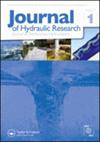Effect of leading-edge geometry on flow beneath a simulated ice block
IF 1.7
3区 工程技术
Q3 ENGINEERING, CIVIL
引用次数: 0
Abstract
AbstractThe present article conducted detailed velocity measurements beneath simulated ice blocks with different leading-edge geometries (round, rectangular, upward and downward triangular). The results examined flow separation at the leading-edge, vortex generation, and subsequent vortex propagation. The instantaneous velocity field depicts an unsteady flow dominated by large-scale vortices, with the Kelvin–Helmholtz type instability dominating the shear layer interface. The mode of vortex generation and propagation was influenced by the geometry of the leading edge. These vortices were dominant for the rectangular and upward triangular configurations. Propagation of these vortices creates low-pressure zones beneath the simulated ice block, which can affect the ice block stability. For all ice blocks, the mean flow accelerated, due to flow separation, and this can result in fluctuations in the dynamic pressure field. These events can lead to greater under-turning moments, as well as the interfacial melting of the ice.Keywords: Geometryice blockleading-edgesimulatedstabilityvortices AcknowledgementThe authors are grateful to the Natural Sciences and Engineering Research Council of Canada for their financial support. We also thank Alexander Wall for his assistance in machining the set-up.Disclosure statementNo potential conflict of interest was reported by the author(s).前缘几何形状对模拟冰块下流动的影响
摘要本文在不同前缘几何形状(圆形、矩形、向上和向下三角形)的模拟冰块下进行了详细的速度测量。研究结果考察了前缘的流动分离、涡的产生和随后的涡传播。瞬时速度场描述了一个以大尺度涡旋为主的非定常流场,剪切层界面以开尔文-亥姆霍兹型不稳定性为主。涡的产生和传播方式受前缘几何形状的影响。这些涡旋在矩形和向上三角形构型中占主导地位。这些涡旋的传播会在模拟冰块下方形成低压区,从而影响冰块的稳定性。对于所有冰块,由于流动分离,平均流动加速,这可能导致动压力场的波动。这些事件可能导致更大的下倾时刻,以及冰的界面融化。本文作者感谢加拿大自然科学与工程研究理事会的资金支持。我们也感谢Alexander Wall在机加工设置方面的协助。披露声明作者未报告潜在的利益冲突。
本文章由计算机程序翻译,如有差异,请以英文原文为准。
求助全文
约1分钟内获得全文
求助全文
来源期刊

Journal of Hydraulic Research
工程技术-工程:土木
CiteScore
4.90
自引率
4.30%
发文量
55
审稿时长
6.6 months
期刊介绍:
The Journal of Hydraulic Research (JHR) is the flagship journal of the International Association for Hydro-Environment Engineering and Research (IAHR). It publishes research papers in theoretical, experimental and computational hydraulics and fluid mechanics, particularly relating to rivers, lakes, estuaries, coasts, constructed waterways, and some internal flows such as pipe flows. To reflect current tendencies in water research, outcomes of interdisciplinary hydro-environment studies with a strong fluid mechanical component are especially invited. Although the preference is given to the fundamental issues, the papers focusing on important unconventional or emerging applications of broad interest are also welcome.
 求助内容:
求助内容: 应助结果提醒方式:
应助结果提醒方式:


